Core i7 Overclocking
One of the great attractions of the Intel Core i7 is its fantastic overclocking ability. As shown in Overclocking Core i7, the overclocking ability varies by CPU and the chip's onboard memory controller. Still, overclocks of the 2.66GHz 920 chip normally can reach 3.6GHz to 4.0GHz with air-cooling - and even higher with water- and phase-change-cooling.
As discussed in many overclocking articles here, there are normally two types of overclockers. First are those who overclock for value, which are those that select cheaper parts rated at lower specs for their ability to overclock to much higher performance levels. Second, there are overclockers who try to reach the highest overclock possible, and who usually choose the highest priced and higher-performance parts to overclock even further. This Core i7 Overclocking System leans toward the value side of the overclocking equation. Generally parts were selected, like the Core i7 920, because they are a good value that becomes an outstanding value when overclocked. Where an alternative exists that would be a better choice for the "absolute" overclocker it will be pointed out.
| Intel Core i7 Overclocking PC | ||
| Hardware | Component | Price |
| Processor | Intel Core i7 920 Socket 1366 (2.66GHz Quad-core, 4x256KB L2, 8MB L3 Cache) |
$295 |
| Cooling | Thermalright Ultra-120 eXtreme-1366 RT | $75 |
| Video | MSI R4870-T2D1G Radeon HD 4870 1GB | $205 |
| Motherboard | DFI LP UT X58-T3eH8 X58 - Retail | $300 |
| Memory | Kingston HyperX T1 3GB (3x1GB) DDR3-1866 (PC3-14900) Kit KHX14900D3T1K3/3GXR | $159 |
| Hard Drive | Seagate Barracuda 7200.11 ST31000333AS 1TB | $105 |
| Optical Drive | LG 6X BD-R 2X BD-RE 16X DVD+R 6X Blu-ray DVD-ROM SATA Blu-ray Burner GGW-H20LK | $190 |
| Audio | On Board | - |
| Case | Antec Nine Hundred Black Steel ATX Mid Tower | $100 |
| Power Supply | CORSAIR CMPSU-850TX 850W SLI Ready CrossFire Ready 80+ Certified | $130 |
| Display | ASUS VW246H Black 24" 2ms (GTG) HDMI 1080P | $290 |
| Speakers | Logitech G51 155W RMS 5.1 Speakers - Retail | $90 |
| Keyboard | Logitech G11 USB Gaming Keyboard | $59 |
| Mouse | Logitech MX518 8-Button/1 Wheel USB 1800dpi Laser Mouse | $40 |
| Operating System | Microsoft Vista Home Premium OEM | $99 |
| Bottom Line | $2137 | |
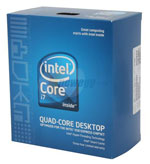 |
The i7 920 is the lowest priced Intel Core i7 you can currently buy. It is normally the choice for overclockers because it can reach as high as 4.0GHz with air-cooling if you are lucky enough to find one with a strong on-chip memory controller. Even those that don't reach the top normally make it to 3.6GHz without too much effort. That represents a huge performance boost for an entry-level part - even a high-end "entry" CPU.
In our look at overclocking in the Phenom II Launch review, the Core i7 920 reached as high as 3.8GHz at stock voltage and 4.0 GHz when overvolted to 1.35V. That is a 50% overclock. You start with a processor that is 30% faster in some tests compared to a Core 2 or Phenom II, and then you find you can also overclock this 2.66GHz CPU to 3.8GHz to 4GHz with careful tweaking and better cooling. You will certainly be very happy with Core i7 base performance, but in overclocking you will be ecstatic with this CPU.
The one drawback of the 920 is the locked 20X multiplier. Overclocking can only be achieved by increasing the "bus" speed (there really is no "bus speed" in the i7 design). The only Core i7 with an unlocked multiplier is the Core i7 965. That processor is an excellent choice if you prefer the multiplier route to overclocking or if you want the multiplier available as one of the variable OC parameters. However, be prepared for a significant increase in price. The Core i7 965 street price is around $1000.
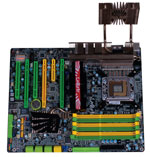 |
The DFI LP UT X58-T3eH8 LGA 1366 is the best overclocking socket 1366 motherboard we have tested so far. DFI is a motherboard name with a long history of overclocking champions, and the new LAN Party UT X58 will not disappoint. Recent DFI boards have been some of the best overclocking designs we have seen from DFI. The company hired some engineers from the old Abit and their influence is certainly seen in recent designs. The DFI X58-T3eH8 is also compatible with either CrossFire or SLI, which provides great flexibility in selecting a GPU. The entry i7 Gigabyte GA-EX58-UD3R is a superb motherboard, but it is CrossFire only. That is not really an issue if you select an AMD video card, but it does somewhat limit choices for future expansion. With both CrossFire and SLI compatibility, the DFI can go wherever the GPU market leads and still support future expansion to multiple GPUs.
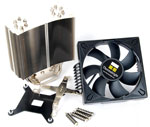 |
Several well-known coolers offer optional adapters for socket 1366, but the cooler choice to mate with the DFI X58 board for overclocking is the Thermalright Ultra-120 eXtreme-1366 RT. This is basically the top performing Thermalright Ultra-120 eXtreme from our Core 2 tests combined with a socket 1366 adapter and an included quiet high-performance 120mm fan. There are several socket 1366 coolers in the lab for testing and we will have more to say about their performance in the next few weeks. The Thermalright socket 1366 is a good choice for Core i7 overclocking.
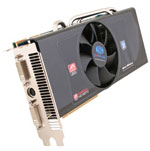 |
It is very difficult to recommend an NVIDIA GTX 285, or even the GTX 280, when the similar performing Radeon 4870 1GB is available for $135 less at $205. Our choice for the GPU is the MSI R4870-T2D1G Radeon HD 4870 1GB, which is the same card used in our Core i7 Entry System. The NVIDIA GTX 280 and GTX 285 are excellent alternatives if you can handle the 50% higher price or if the prices drop. We actually still prefer the performance of the NVIDIA cards on Core i7, but the price difference is hard to swallow.
Memory for overclocking the Core i7 needs to have a very wide operating range to keep up with the higher "bus" speeds needed to overclock the i7 920. The highest speed production memory you can currently buy, with performance warranted at rated speed, are the DDR3-2000 3GB kits. Right now the 3GB memory kits are also better at the higher speeds than 6GB triple-channel kits. That will be changing soon, however, as higher speed 6GB kits are starting to make their way to market.
 |
Our selection is close to the highest speed available with the top-performing Kingston HyperX T1 3GB (3x1GB) DDR3-1866 (PC3-14900) triple channel kit. You are guaranteed a latitude to DDR3-1866 above the normal speed of DDR3-1333. You can also dial down the base speed to 1066 to squeeze even more range from the memory. Kingston normally rates their HyperX memory conservatively and it is likely to perform even better than rated. If you want the fastest 3GB kit you can buy you can choose the 3GB DDR3-2000 kit from G.Skill or the hard to find DDR3-2000 kit produced by Kingston. The Mushkin DDR3-1600 kit used in the Dream i7 system is also a good choice because of the very fast rated timings of 7-8-7 at DDR3-1600 in a 6GB memory kit instead of the 3GB we chose for this i7 OC system.
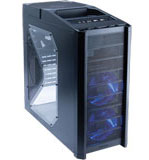 |
The case receives an upgrade with the selection of the well-regarded Antec Nine Hundred which bottom mounts the power supply and provides plenty of internal storage. Cooling is provided by 120mm fans and a massive 200mm top exhaust fan. The Nine Hundred is a great choice for an overclocking case that will use air-cooling. There is also the upgrade Nine Hundred Two for about $50 more.
 |
An overclocking power supply for the Core i7 needs plenty of reserve power provided by a conservative design with solid build quality. The 850W Corsair CMPSU-850TX should be able to handle whatever you want to do with this i7 system. It is 80 Plus certified and provides 12V power on a single rail. There is also the fact that Corsair has a reputation for conservatively rating their power supplies, which means this 850W should be as good as many other 1000W power supplies. That makes the 850TX a great value at just $140 after rebate.
An SSD (Solid State Drive) would be a great addition for a boot drive and/or game drive in this Core i7 OC system. The problem is we don't yet know which SSD to recommend. AnandTech is in the process of testing the latest generation of cheaper SATA II designs, but until this is complete it would be impossible to recommend any SSD other than the expensive Intel 80GB and 160GB SSDs. In our previous tests, the earlier SSDs were plagued with data corruption issues as the drive neared capacity and with annoying random pauses that were particularly troublesome in gaming. Anand is in the process as this goes to press of evaluating new SSDs for an upcoming review. Be sure to look for his SSD roundup and recommendations for an SSD. I have been using a very reasonable G.Skill 64GB SATA II SSD with good results for several weeks. The SSD is just $129 and the entire Windows 7 beta system with all drivers occupies just 30GB of the 64GB available. My subjective experience has been good, but this is one of the drives included in the SSD roundup where it will be tested in a more systematic manner.
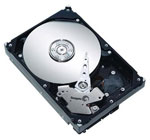 |
Our storage drive selection for the Core i7 Overclocking system is the Seagate Barracuda 1TB drive (1000GB). While the Seagate 1.5TB drive and the early 1.0TB drive were plagued with firmware problems at their release, the performance and reliability of this later 1TB Seagate has been excellent in our testing so far. For a price of around $100 the value is incredible. While there are differences between hard drives, outside of running benchmarks most people aren't likely to notice the difference in performance between Western Digital, Seagate, Samsung, Hitachi, and other major brands. All are worthy of consideration if the price per gigabyte (or terabyte) is right.
 |
We feel the optical drive for the Core i7 OC system needs to both play Blu-ray disks and burn 25GB/50GB Blu-ray discs. We have upgraded the optical drive to the flexible LG GGW-H20LK burner, which is now selling for just $190 and has the ability to both read and write Blu-ray disks. It also can burn DVDs at 16x speed in single or dual-layer formats.
The onboard audio solution is adequate for most of today's computer users. That is why we stuck with the onboard audio on the DFI. This also removes one more overclocking variable in that it is easy to turn off onboard audio if for some reason it becomes an impediment to overclocking. If you are heavily invested in game titles that do best on a Sound Blaster card, you might consider a Creative Labs sound card. If you gravitate toward audiophile quality, the ASUS Xonar 1.1 is a good upgrade.
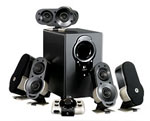 |
Speakers have been upgraded to the Logitech G51 155W RMS 5.1 surround sound speakers. They are selling for $90 after a $40 rebate, which is a great value on these well-regarded powered speakers.
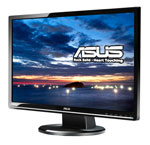 |
The LCD display resolution is the same 1080p HD resolution chosen for the value midrange systems; the size of the monitor however is increased to 24" so everything on screen is just a little larger. The ASUS VW246H 24" 2ms (GTG) HDMI provides the preferred DVI and HDMI inputs, as well as an analog VGA port. Panel speed is rated at 2ms, but we have found most current LCD panels perform similarly and the speed rating does not really guarantee very much. The ASUS monitor provides a sharp image, good colors, and fast panel speed at a very good price of $290. For more information on what matters in a monitor and how to read LCD specifications take a look at our Holiday 2008 Display Guide.
It is worth pointing out that all the LCD monitors from the new class of 21.5" full 1080p to the large 28" monitors all feature resolutions of 1920x1200 or 1920x1080. Older 22" monitors are 1680x1050. The point here is that for higher resolution - higher than 1920 horizontal resolution that is - the next step in monitors is the 30" 2560x1600 displays. Moving up to a 26"-28" LCD gives bigger pixels, not a higher resolution. (Yes, there are also a few 23" LCDs with a slightly higher 16:9 resolution, like the Dell SP2309w, but 2048x1152 isn't a huge step up.) Also note that nearly all new 21" to 28" LCDs are using TN panels instead of S-PVA or S-IPS, particularly the inexpensive options. There's a reason some 24" LCDs still cost over $500.
The Bottom Line for the Core i7 Overclocking System is $2137 for the complete system. We are confident that with a little effort you can overclock this system to 3.6GHz to 4.0GHz on air-cooling. Of course, we could never guarantee that result as components do vary in their capabilities, but you should have every expectation that this Core i7 OC System can easily perform at levels higher than the $1010 Core i7 965, which is specified at 3.2GHz.










106 Comments
View All Comments
Hxx - Thursday, February 5, 2009 - link
I agree, with the right sound card, a good 2.1 would prove a much better investment than an entry level 5.1 surround. But of course, there's also the logitech g51:-)goinginstyle - Thursday, February 5, 2009 - link
I was thinking the same thing about the audio choices. They are all over the map and no options for home theater or gaming in the dream system. On the budget or overclocking system I would much rather have a great sounding 2.0 or 2.1 setup or even headphones than a cheap 5.1 system.Of course it totally blows the budget point here but a set of Swans M10/M12 would work on the low end system and blows away just about everything in the under $100 market, D1080MKII for midrange at $125 now and they sound almost as good as the next choice, which is the M200 MKII at the high end ($189) for the more musically inclined. Or something similar to those choices from another decent supplier of audio, even the Klipsch ProMedia 2.1 can be had for around a $100 now or the M-Audio AV30s at $99. A good sound card is needed to get the best out of these speakers but they will even make onboard audio sound better.
I will not argue too much about the dream speaker setup considering the emphasis is on PC audio that includes games but why not consider the Auzentech X-FI Forte for the sound card then or the X-FI HT HD for both gaming and home theater.
It just seems as if the audio section was slapped together as an after thought. At least give some alternatives for each setup to mix and match, that holds true for the other stuff as well. List a primary setup in detail like you have and then have a separate box for alternatives. One would have to assume that there is at least two choices in the best of categories listed in the article.
Kinshinlink - Thursday, February 5, 2009 - link
this is insane. i thought an entry system would have fewer luxuries than this build would. a 1080p screen? a 1 TB drive, who uses that much storage? i have about 30 dvd quality movies, tons of music, and a bunch of modern games installed, some of which have multiple installation folders and i am only using 200 GB at most. the video card is good but is it entry? more like a 9800gt id think. surround sound? a 700 watt power supply powering one card? and an expensive optical drive. i didn't know everyone was a gamer or multimedia enthusiast these days....oh excuse me i used the term lightly, because i didn't mention quad sli or cfx when referring to gamer. some people have budgets, and when they do i doubt they look for an article like this relating to "entry", when you could easily save hundreds of dollars if your just wanting to taste i7.Wesley Fink - Thursday, February 5, 2009 - link
With 2TB drives launching soon I never imagined the selection of a $95 1TB hard drive would be called extravagant. By all means refer back to the Under $1000 guide if that better meets your needs and save $30 by choosing a 500GB drive instead.I don't see the point of buying a Core i7 if you don't need or won't use the power of the CPU. Saddling even the Entry i7 with a sub-standard graphics system is poor value. If the cheapest 1080p monitor on the market at $190 is too much you can crank down the monitor and select a cheaper video card. Then, why bother with an i7 - buy a cheaper and capable CPU and upgrade your monitor and video to improve overall system performance.
I confess that I really don't understand why you would buy an house in Beverly Hills, even the cheapest house in Beverly Hills, and fill it with K-Mart knock down furniture.
Tacoeater - Tuesday, March 3, 2009 - link
Really? You can't imagine someone buying a house in Beverly Hills. It is called house rich, cash poor. But really? Wouldn't the equity you create in a house in Beverly Hills be worth it. I think this is a bad example since houses are investments and people buy too much house all the time. Consider the current times as evidence of this fact.JarredWalton - Thursday, February 5, 2009 - link
On a related note, it's worth noting that CUDA for NVIDIA GPUs and other GPGPU tools (OpenCL, DX11) are really starting to show promise (i.e. Photoshop CS4 uses some GPU acceleration), so at some point you may seriously consider buying a cheaper CPU with a top-end GPU for computational work. That's what Tesla is targeted at, for example. A $200 GPU for a Core i7 makes perfect sense; if you don't need a $200 GPU, I can't imagine why you'd really need eight logical cores. Maybe all you do is 3D rendering or video work... but don't those benefit from a decent GPU as well?strikeback03 - Thursday, February 5, 2009 - link
I was going to state that prior to the release of CS4, I had zero use for 3D capabilities higher than that provided by integrated graphics. If I were going to build a system today, I would aim for under $100 on the video card and see if it actually helped much, if some killer app for GPGPU does actually come out can always upgrade.just4U - Thursday, February 5, 2009 - link
One thing I'd require in a build, is atleast 4gig's of ram. If your forking out 1000+ it should be manditory... Or with the case of i7 6gigs.Spivonious - Thursday, February 5, 2009 - link
I agree. The "entry" system is more like a "under $2000" system. I bet with some effort you could build a solidly performing i7 system for under $1000.crimson117 - Thursday, February 5, 2009 - link
If you want the cheapest possible system that for some reason still uses a high end processor like the Core i7, then just take the http://www.anandtech.com/guides/showdoc.aspx?i=348...">Intel Entry Level PC and swap in the cheapest x58 motherboard and cheapest DDR3 ram.It's not a common or realistic scenario to budget for a top-end processor and skimp on everything else. For the money, a decent core 2 duo setup at the same budget will provide a much better overall computing experience than a gimped core i7 system.